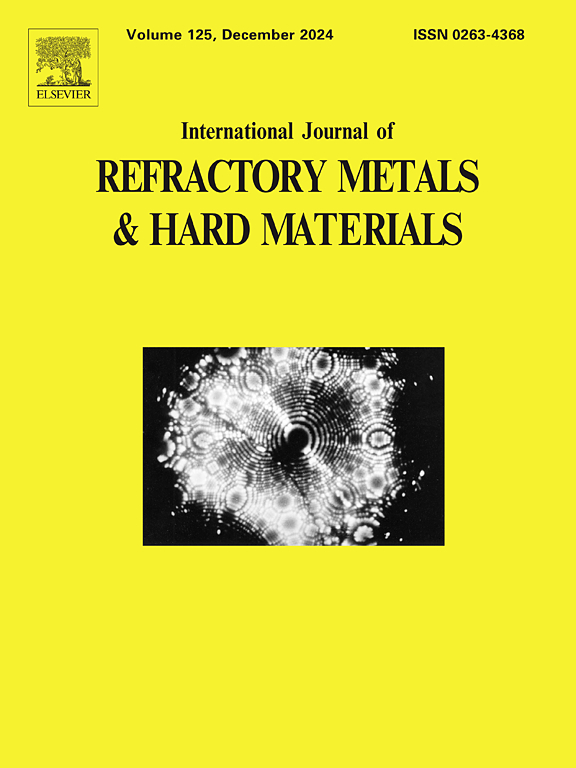表面能和塑性在决定钽和钨断裂韧性中的作用
IF 4.2
2区 材料科学
Q2 MATERIALS SCIENCE, MULTIDISCIPLINARY
International Journal of Refractory Metals & Hard Materials
Pub Date : 2025-05-08
DOI:10.1016/j.ijrmhm.2025.107222
引用次数: 0
摘要
本研究通过考察杂质对钨(W)和钽(Ta)理想解理能和断裂韧性的影响,量化了杂质对钨(W)和钽(Ta)断裂行为的影响。利用密度泛函理论(DFT),我们计算了W和Ta的{100}和{110}晶面的理想解理能因各种杂质而降低,其中He、O、P和S表现出明显的脆化效应。这些减少量被转换为断裂韧性,并纳入位错动力学模型,以预测脆性到韧性转变(BDT)的变化。虽然这两种金属在杂质引入后都表现出脆性增加,但钨对这些影响更敏感。此外,即使在超纯钨中,晶界处的杂质偏析也会由于局部较高的杂质浓度而加剧脆化,尽管这种偏析的实验证据仍然有限。然而,在超纯钨中发现的少量杂质(小于0.1%)对单晶钨的断裂行为影响最小。这项工作提供了杂质对W和Ta断裂性能影响的全面评估,为高温应用提供了重要的见解。本文章由计算机程序翻译,如有差异,请以英文原文为准。

The role of surface energy and plasticity in determining the fracture toughness of tantalum and tungsten
This study quantifies the influence of impurities on the fracture behavior of tungsten (W) and tantalum (Ta) by examining their effects on ideal cleavage energy and fracture toughness. Using density functional theory (DFT), we calculated the reduction in ideal cleavage energy for both the {100} and {110} crystallographic planes of W and Ta due to various impurities, with He, O, P, and S showing significant embrittling effects. These reductions are converted to fracture toughness and incorporated into a dislocation dynamics model to predict changes in the brittle-to-ductile transition (BDT). While both metals exhibit increased brittleness with impurity introduction, tungsten is more sensitive to these effects. Additionally, impurity segregation at grain boundaries, even in ultrapure tungsten, could exacerbate embrittlement due to locally higher impurity concentrations, though experimental evidence for this segregation remains limited. However, small amounts (less than 0.1 %) of impurities, as found in ultrapure tungsten, have minimal impact on the fracture behavior of single-crystal tungsten. This work provides a comprehensive assessment of impurity effects on the fracture properties of W and Ta, offering critical insights for high-temperature applications.
求助全文
通过发布文献求助,成功后即可免费获取论文全文。
去求助
来源期刊
CiteScore
7.00
自引率
13.90%
发文量
236
审稿时长
35 days
期刊介绍:
The International Journal of Refractory Metals and Hard Materials (IJRMHM) publishes original research articles concerned with all aspects of refractory metals and hard materials. Refractory metals are defined as metals with melting points higher than 1800 °C. These are tungsten, molybdenum, chromium, tantalum, niobium, hafnium, and rhenium, as well as many compounds and alloys based thereupon. Hard materials that are included in the scope of this journal are defined as materials with hardness values higher than 1000 kg/mm2, primarily intended for applications as manufacturing tools or wear resistant components in mechanical systems. Thus they encompass carbides, nitrides and borides of metals, and related compounds. A special focus of this journal is put on the family of hardmetals, which is also known as cemented tungsten carbide, and cermets which are based on titanium carbide and carbonitrides with or without a metal binder. Ceramics and superhard materials including diamond and cubic boron nitride may also be accepted provided the subject material is presented as hard materials as defined above.

 求助内容:
求助内容: 应助结果提醒方式:
应助结果提醒方式:


